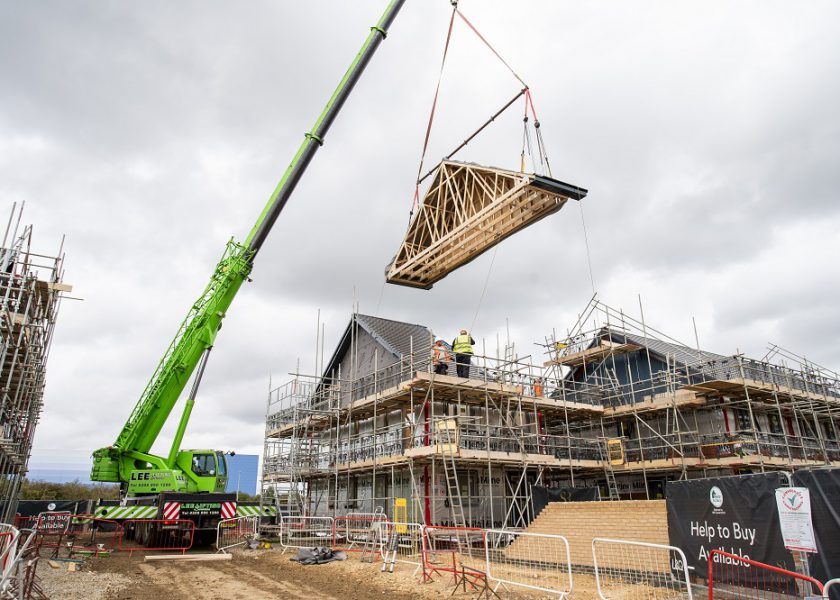AIMCH constant evolution
14/07/2021

Advanced Industrialised Methods for the Construction of Homes (AIMCH), the innovation consortium set up to transform the housebuilding sector, has published its second-year progress report and highlights some fundamental learning points.
AIMCH is a three-year research and development project aiming to help tackle the UK housing crisis by building new homes faster, to higher quality and more cost effectively than masonry methods using panelised offsite systems. The latest report highlights several key learnings for the industry across several important and innovative areas. One of the highlights being able to achieve a weathertight, insulated and secure superstructure in just one day. All advanced panelised offsite systems and lean construction solutions trialled so far have been successful and early analysis is recognising the benefits of these systems with the hard data to back it up. Other important outputs of the project in the last year include the completion of several studies and the publication of guides for industry including:
• Design standardisation and the development of product families
• Guide to creating a BIM housing manual
• Design for Manufacturing and Assembly (DfMA)
• Designing a future factory.
“Despite the challenges of COVID-19 the project team has worked hard to build momentum,” says Stewart Dalgarno, AIMCH Project Director and Stewart Milne Group Director of Product Development. “It has delivered some important outputs which confirm panelised MMC as a very real and viable alternative to masonry, over the final year, we hope to take this to a new level.”
Monitoring has taken place on 42 plots (23 Barratt and 19 L&Q), with over 100,000 operative observations recorded and 500,000 pieces of data collected and used to evaluate masonry, timber frame and advanced closed panel MMC methods.
A collaboration between Stewart Milne Group, Barratt Developments, L&Q, Forster Group, the Manufacturing Technology Centre (MTC) and Construction Scotland Innovation Centre (CSIC), the project compares conventional and panelised MMC construction methods on actual building sites, and the impact scaling up panelised MMC will have on the housebuilding industry. The three-year project, which has been live since early 2019, has been trialling new digital design tools, manufacturing advancements, and improved near-to-market offsite panelised systems, using lean site processes on live housing projects over the past two years.
Standardisation of subassemblies and the creation of product families, within housing design, as a mainstream industrialised process, is a significant shift for the AIMCH developers and wider industry.
Mark Farmer, the Government’s MMC Champion for Housebuilding and new AIMCH Chair, said: “Mainstreaming all categories of MMC is more important than ever. In a post-COVID world the sector needs to transform productivity, improve quality as well as improving the welfare of its workforce. We also need to find more sustainable ways of building in order to achieve a net zerocarbon built environment.
“The AIMCH project has already made great progress across a number of fronts which will better enable greater MMC adoption across all parts of industry including SME’s. The work done on design standardisation, panelised and sub-assembly system applications, productivity and carbon measurement and manufacturing process optimisation are all rich sources of knowledge for others to learn from and use.”
The completion of Future Factory Simulation has paved the way for Offsite Manufacturing (OSM) companies to make more agile decisions about increasing capacity to the market by using modelling and simulation tools to support and control digital factory planning activities.
The project recognises the challenges of MMC manufacturing and through engagement with MTC, lead manufacturing partner, has conducted advanced manufacturing and digital business systems studies. These include down selection process for an integrated ERP system for MMC manufacturing and installation, along with detailed proof of concept studies into specific manufacturing areas, where using robotics and advanced automation can improve MMC manufacturing output, productivity, quality and lower costs, including the design of future factories using mathematical models, dynamic simulation and 3D technology to improve investment decisions.
With decarbonisation of the built environment a priority, the project embarked on a study to measure and profile Embodied Carbon and Whole Life Costing in the use of MMC systems across four housing types to current and near zero carbon standards. A strategy for a proof of concept, near zero carbon home trial was also developed with Barratt Developments. The project also recognises the importance of SMEs and through Forster Group, roofing specialist, has helped accelerate their roofing technology, through collaborative learning and proof of concept trials with MTC and the AIMCH developers. Dissemination is important and provided by CSIC including presenting at several key industry events, a dedicated industry stakeholder group, project website and social media.
The housing industry is well suited to BIM adoption, where the benefits of a standardised designs, collaborative procurement and repeatable processes are inherently built into the housebuilding delivery process.
The goal of the project is to support the sector by delivering 120,000 homes for the same or less cost than traditional methods and built 30% quicker. The project has potential to impact on 35,000 homes being delivered by AIMCH partners across the UK each year. In the project’s final year, a number of outputs and learnings for the sector will be completed and shared on the AIMCH website as well as at industry events, with final findings published in March 2022.
As traditional resources of labour and materials become more expensive and limited and with the journey towards greater energy efficiency and carbon neutrality, it is now more important than ever to achieve cost certainty, better quality, speedier build and reduction in carbon footprint.
To read the full article, go to Offsite Magazine here.